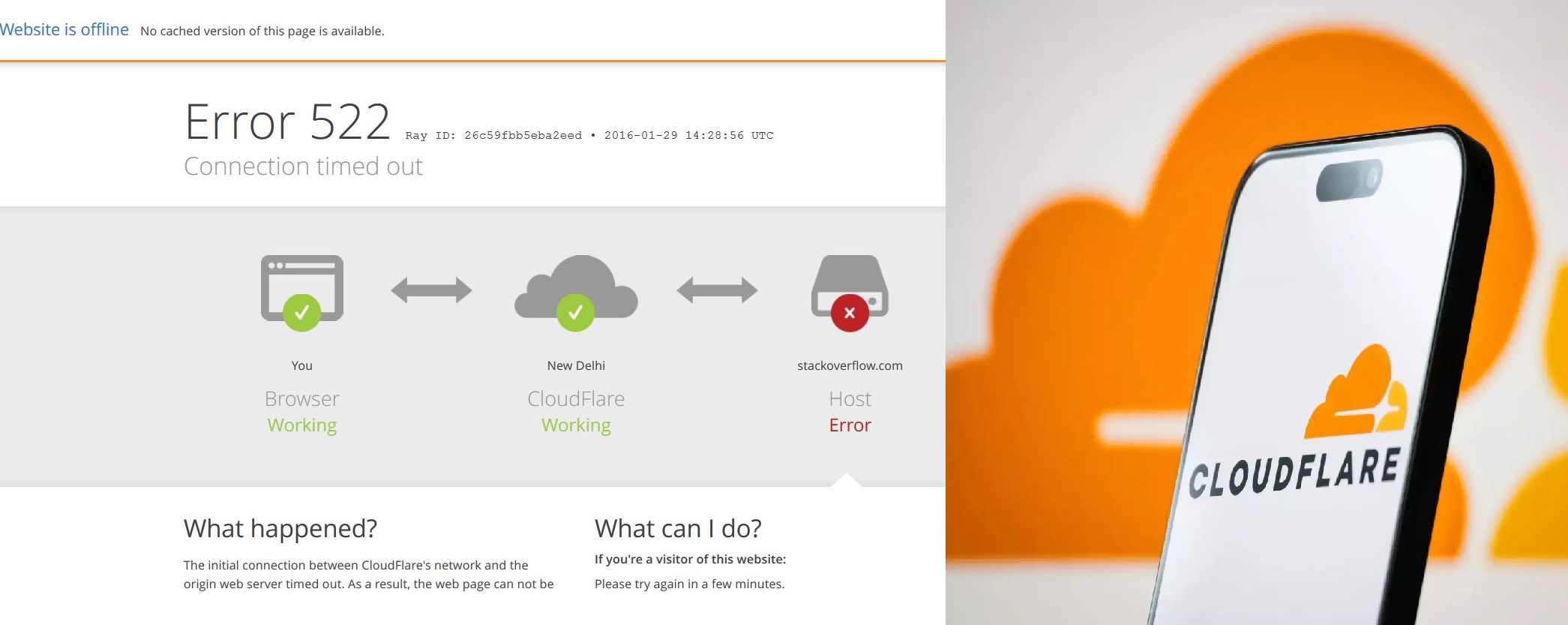Cloudflare Outage Knocks X, ChatGPT and Large Sections of the Internet Offline

A major outage at internet infrastructure giant Cloudflare briefly broke a massive portion of the global web on Tuesday, disrupting access to X, ChatGPT, Downdetector, and thousands of other websites across continents. Because Cloudflare sits in front of an estimated 20% of all active websites worldwide, even a single internal failure resulted in widespread slowdowns, error messages and complete service outages for millions of users.
A Routine Update Turns Into a Global Web Shock
The disruption began around 12:03 UTC, when Cloudflare reported “internal service degradation” and warned that multiple services might be intermittently impacted. As the issue spread, major platforms started showing 500 errors, failed logins and frozen feeds. Downdetector’s own reporting tools struggled, and global traffic slumped as Cloudflare’s edge network began rejecting requests.
While rumours swirled of a major cyberattack, Cloudflare confirmed the issue was not caused by hackers. Preliminary findings pointed instead to an unexpected interaction between a latent software bug and a routine configuration update that triggered cascading failures across its application services.
Social Media, AI Tools, Games and Banking Apps Affected
The outage hit a wide range of platforms — from social media and AI services to games, fintech applications and cloud-based enterprise systems. Users across Asia, Europe and North America reported issues with:
-
X (formerly Twitter)
-
OpenAI’s ChatGPT
-
Spotify, Uber, Canva, Riot Games services, and numerous crypto exchanges
-
Cloudflare-protected government, banking, and public-service portals
Some websites became totally inaccessible, while others loaded only partially or intermittently, depending on which Cloudflare data centers were affected.
How Cloudflare Responded: Key Status Updates
Cloudflare issued a series of real-time updates throughout the day, documenting the repair process step-by-step.
Issue Identified and First Fix Deployed
By 13:09 UTC, engineers had identified the core problem and began rolling out a fix. Cloudflare also noted temporary limitations, including disabling WARP access in London during remediation. Shortly afterward, Access and WARP services recovered, returning to normal error levels.
Partial Recovery – Continued High Error Rates
Between 14:22 and 15:23 UTC, Cloudflare reported that application services remained unstable and that some customers could still face dashboard login issues, latency spikes, and intermittent failures. Engineers continued working through regional problems and clearing remaining error queues across the network.
Global Recovery Takes Hold
By 16:27 UTC, Cloudflare confirmed that errors and latency were steadily improving, though some users still experienced intermittent failures. The company noted that bot scores — used to assess and filter suspicious traffic — would also be affected until full recovery was achieved.
Current Status (Most Recent Update)
At 17:14 UTC, Cloudflare issued its latest update:
“We continue to monitor the system through recovery and we are seeing errors and latency return to normal levels. A full post-incident investigation and details about the incident will be made available ASAP.”
This message marks the transition from active remediation to post-recovery monitoring, indicating that normal traffic patterns are returning across the network.
Why One Company’s Glitch Broke Part of the Internet
The outage highlights Cloudflare’s position as a critical, though often invisible, foundation of the modern web. Unlike a single website going down, Cloudflare’s malfunction affected every service that depends on its global network:
-
DNS routing
-
DDoS protection
-
Content delivery acceleration
-
API gateways and zero-trust security layers
When these layers fail simultaneously, the result can feel like a partial shutdown of the internet itself.
Experts warn that such incidents raise important questions about centralisation in internet infrastructure — with Cloudflare, Amazon Web Services, Microsoft Azure and Google Cloud becoming massive “choke points” where failures have global consequences.
No Data Breach, No Attack — But a Major Lesson
Cloudflare reiterated that no data breach occurred and that the outage was not the result of an attack. Instead, it was a rare internal systems failure compounded by scale.
A full, detailed post-incident report is expected soon, which will outline exactly how the bug was triggered and what measures will be taken to prevent a repeat.
A Reminder of the Internet’s Fragility
For millions of users, the outage was a temporary inconvenience. But for businesses and governments, it was a reminder that the internet is far more interconnected — and vulnerable — than it appears.
When a single configuration error at a single company can cause outages for 20% of the global web, the stakes of robust, diversified digital infrastructure become clearer than ever.
✍️ This article is written by the team of The Defense News.





